I’m obsessed with Greece.
From the moment I stepped foot in this beautiful country, it was love at first mouthful. There’s something about Greece feels so healing. Being there calms my mind, soothes my worries, and leaves me feeling healthier and stronger than ever. And the food? Guys. I’ve been to over 90 countries and Greece is my number one destination for eating.
I believe Athens is one of the greatest European cities out there, and it’s the perfect destination for a city break. This city is magnificent! With great street art, incredible food, colourful neighbourhoods, and so much history, there really is something for everybody.
I think three days is the perfect amount of time to spend in Athens, so today, I’m excited to share exactly how you can do so.
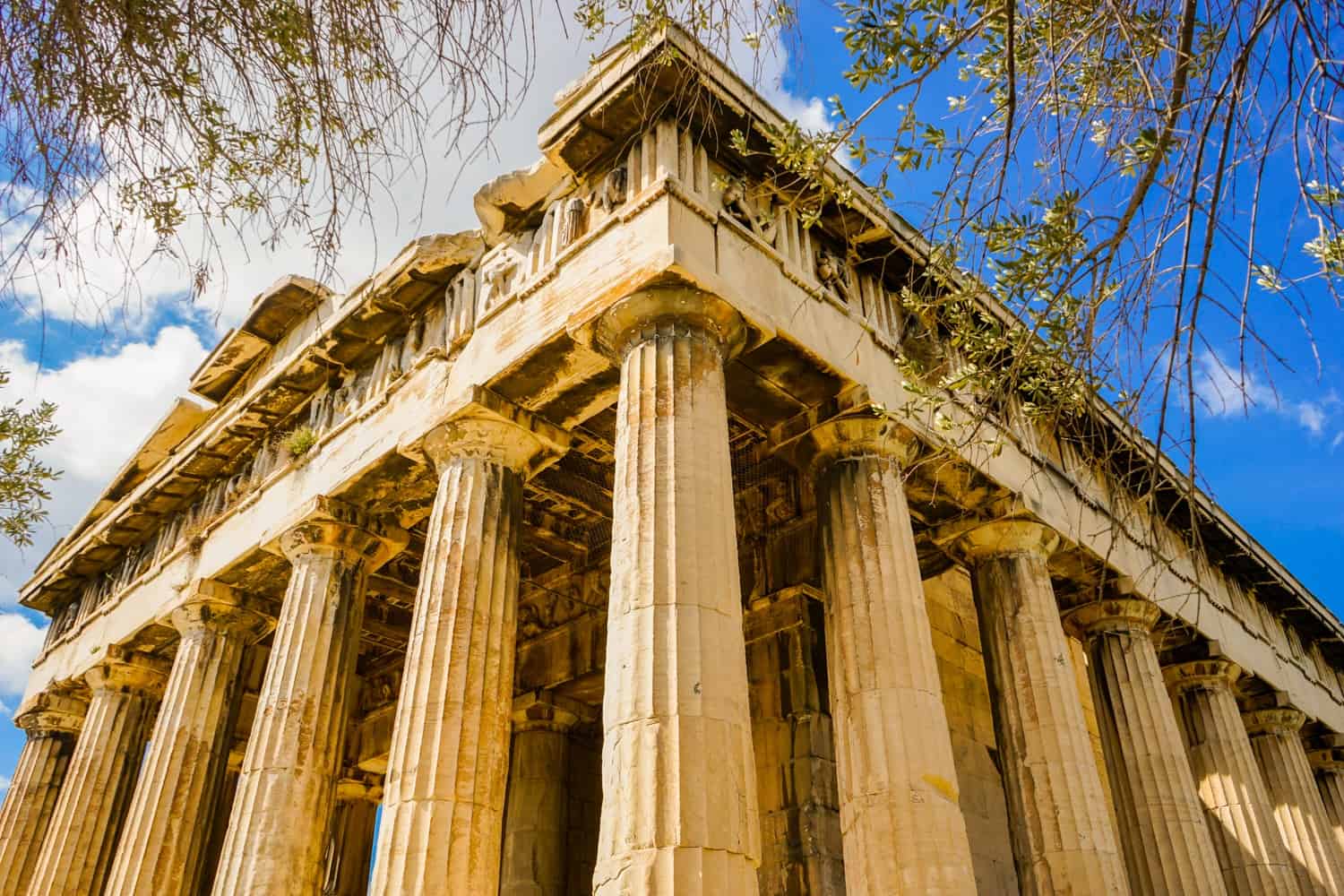
Day One: Begin Diving Into Athen’s History
The first thing you should do in Athens is a no-brainer: buy your combined ticket.
What’s that?
Well, it costs €35, and for that, you’ll gain access to all of the main attractions in Athens, including the Acropolis. Not only will you get to explore the most famous site in the city, but you’ll also be able to enter the Ancient Agora, Roman Agora, Hadrian’s Library, Aristotle’s School, Kerameikos, and the Olympieion — you can visit each of these once over a five-day period, and you can buy the ticket at the entrance to any of them. You’ll save a whole bunch of money by doing this, so the only reason not to get the combined ticket is if you think you’ll only want to see one or two of the attractions.
However, if you happen to be reading this before you get to Athens, I highly recommend buying your combined ticket online. Doing so means you get to avoid the long lines for tickets and can simply show the QR code on your phone to gain entry.
If you haven’t bought your combined ticket online, once you arrive in Athens, head to the Ancient Agora and join the queue for one.
The Ancient Agora was built in the 6th Century BC and was once the centre of life in ancient Athens. Used as a marketplace and gathering spot, this was where you’d have found people like Socrates, Aristotle and Plato casually wandering around town. Almost all of the commercial, political, and social activity took place in the ancient Agora, so this is a hugely important area to check out.
Once you’ve entered the Ancient Agora, head first to the Temple of Hephaestus, which is the best-preserved temple in Athens. And that sure is impressive when you consider that it was built in 415 BC — it’s still in great condition!
The views were pretty acceptable, too.
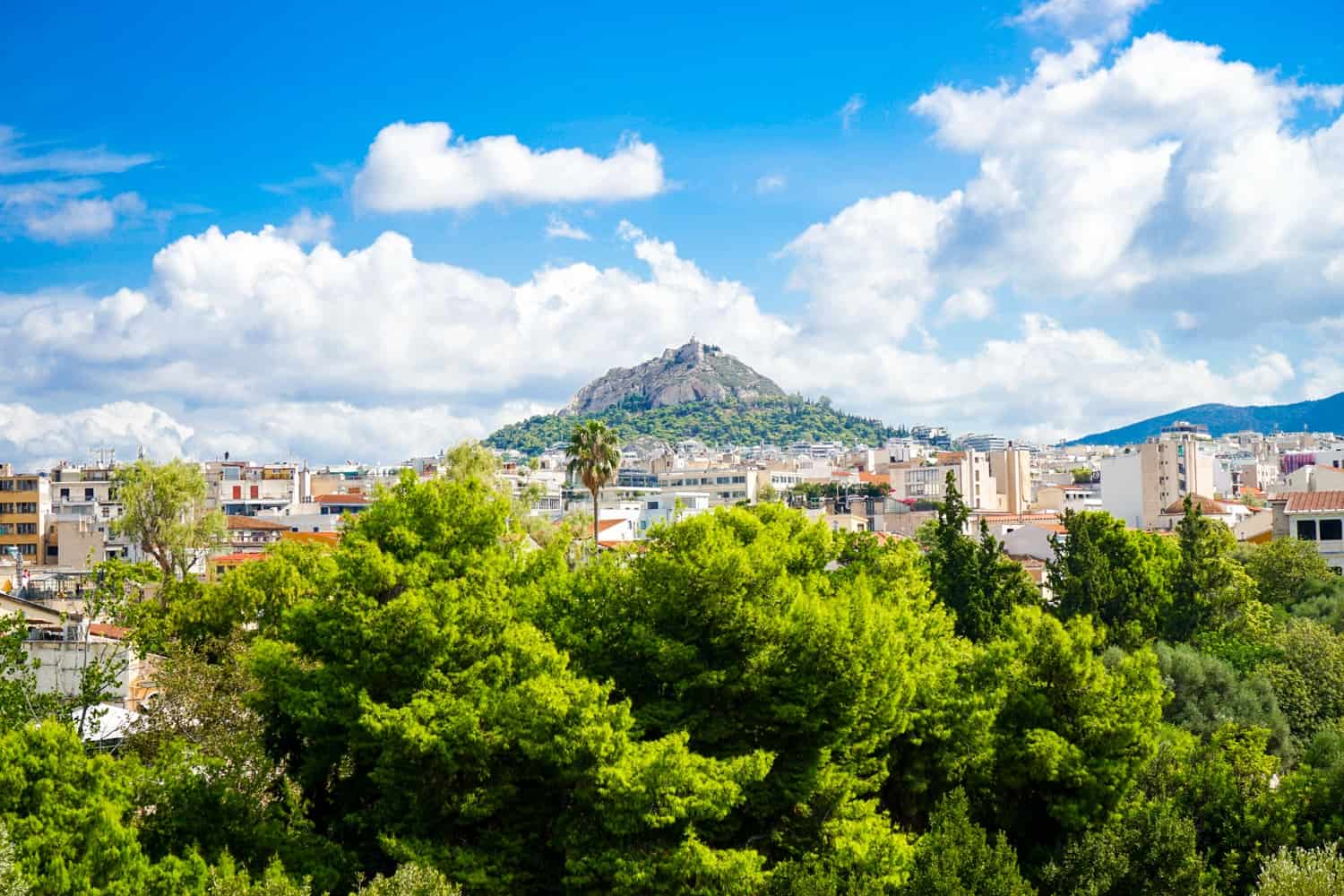
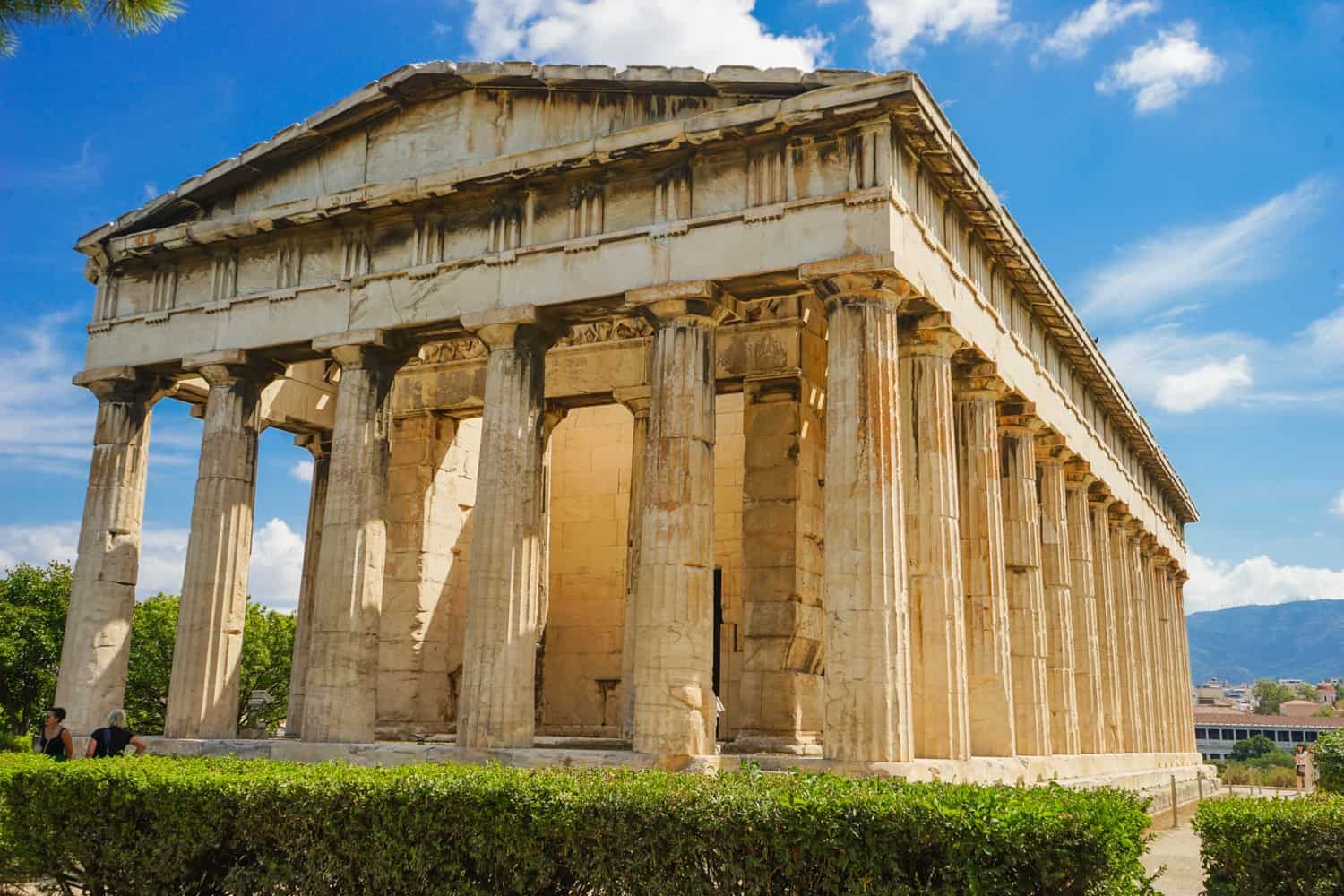
Aside from the Temple of Hephaestus, the Ancient Agora is also home to your standard ruin remnants: collections of rocks, stumps, and fallen-down walls, hinting at the temples and stalls that would have once stood here. But, as always with ruins, you’ll have to use your imagination, because it is still a pile of rocks on the ground.
There’s the Stoa of Attalos here, too — built in the 2nd Century BC, although since reconstructed — which currently acts as a museum for the Ancient Agora. And the Byzantine Church of the Holy Apostles, which was built in 1000 AD, is one of the few structures in the Agora that’s still standing.
Before arriving in Athens, I kind of assumed it would feel like a poor man’s Rome, but at this point, I was well and truly eating my words. Athens was pretty goddamn awe-inspiring.
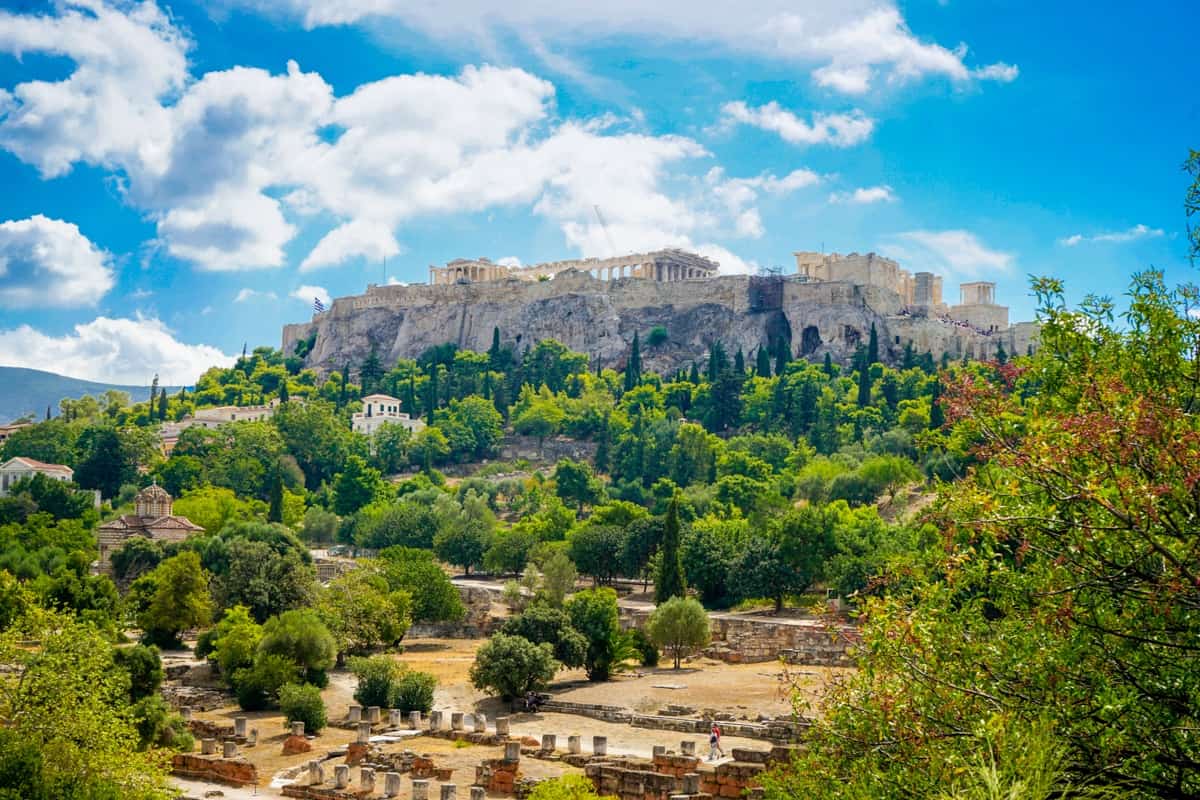
Next, you’ll want to make your way over to the Kerameikos Cemetery, which is another site that’s included in your combined pass. This spot was one of the most important regions of ancient Athens. Once used as a neighbourhood for pottery and painters, it was the place where all of those famous Athenian vases were produced.
It was later transformed into a cemetery: one of Athens’ most important.
As you wander the site, you’ll also be able to spot pieces of the Themistoclean Wall, which was built in 478 BC to protect the city from the Spartans.

I’m convinced that it’s impossible to have a bad meal in Greece: their cuisine is too delicious to mess up. I’ve yet to have a meal that wasn’t excellent in this country, whether I’ve been sat beside a congested motorway in the middle of nowhere, snacking at a taverna on a yacht in the Ionian, or dining in the most touristy parts of Athens.
The latter was exactly what we opted for at lunchtime, and it should have been terrible.
I settled on the most touristy restaurant on the most touristy of streets, with touts outside, and a menu in English with photos of the dishes. What can I say? We were starving by this point, so decided to give in and eat an overpriced, poor meal.
Except it was amazing! Because Greece.
While I wouldn’t necessarily recommend heading to a touristy restaurant for any of your meals in Athens, I suspect you won’t be all that disappointed if you do end up there. Eat anywhere in Athens! It’s always going to be delicious.
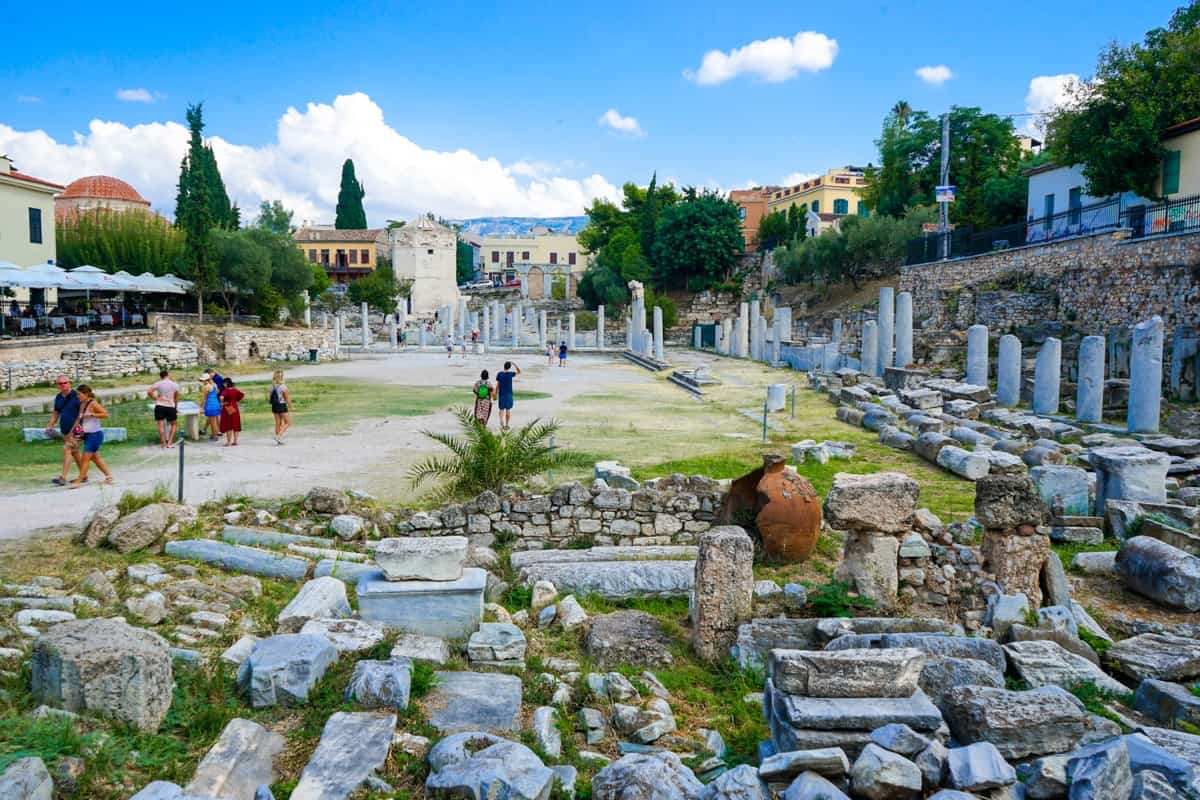
After lunch, it’s time to hit up the second Agora in Athens. The Roman Agora was built in the 1st century BC, financed by Caesar and Augustus, and like the Ancient Agora, was used as the city’s marketplace. You enter the site through the Gate of Athena Archegetis, which was built by Julius Caesar and dedicated to the goddess Athena.
The most well-known and well-preserved building is the Tower of the Winds: a large octagonal marble tower that functions as a sundial, weathervane, and water clock. It’s believed to be the first meteorological station in the world and it’s well-worth having a look inside.
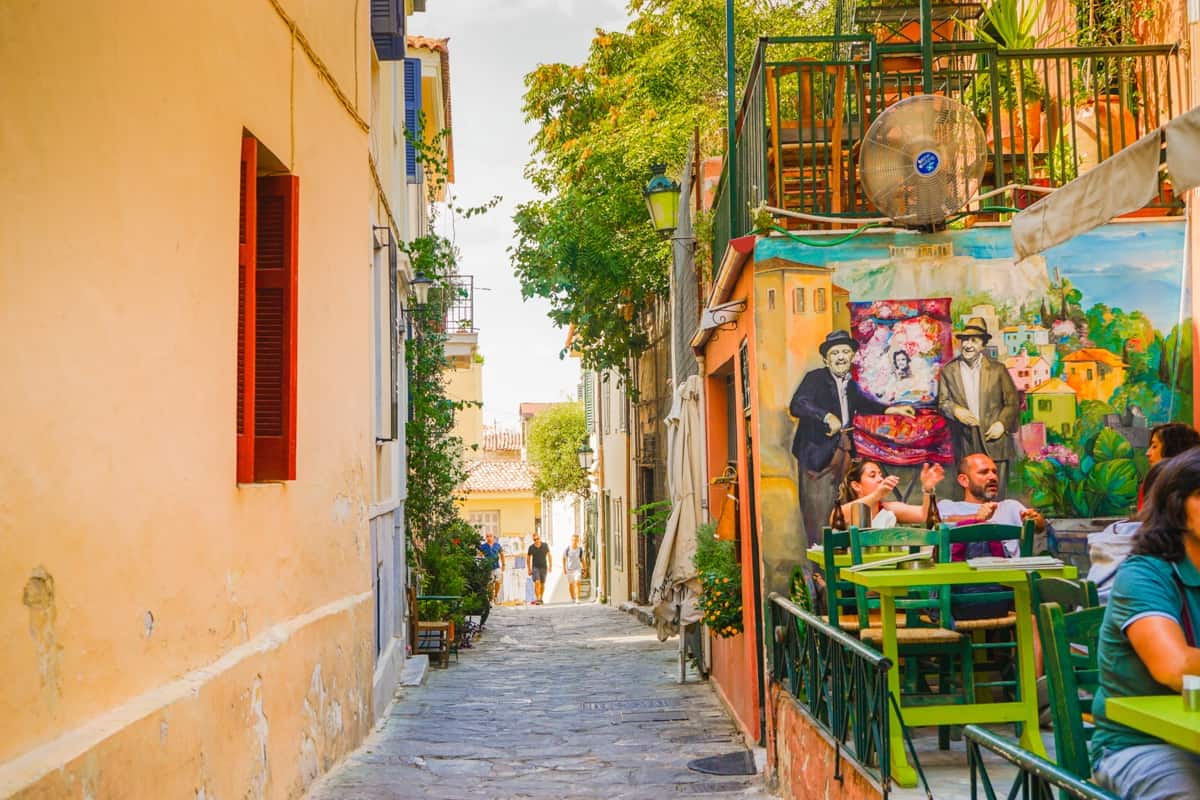
One of my favourite neighbourhoods in Athens was Plaka, so you’re going to want to head there after the Roman Agora. Everybody who spends time in Athens falls in love with this neighbourhood! You could spend hours exploring its photogenic streets.
Plaka is all about clean colourful streets, bustling cafes, and amazing places to eat. It’s popular with visitors, so often busy, but you’ll still love spending an afternoon cafe-hopping through the picturesque streets and taking photos of all of the colours.

While you’re in Plaka, you also have to check out nearby Anafiotika’s white-washed buildings and narrow streets for an insight into what Greek island life is like. The buildings look a lot like what you find on Santorini.
Grab dinner in Plaka or in a restaurant overlooking the Acropolis. You’ll have an early start tomorrow, so you’ll want to get an early night.
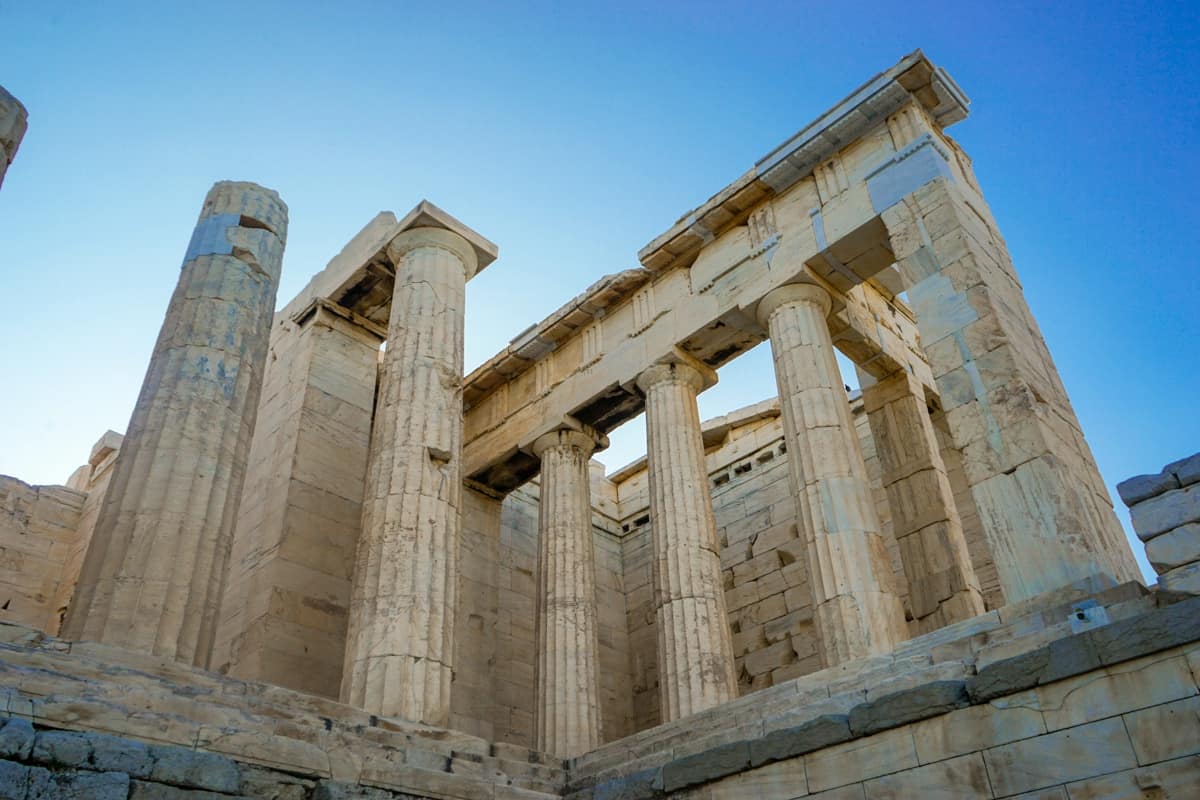
Day Two: All Acropolis, All the Time
Against popular belief, I highly, strenuously, aggressively recommend saving the Acropolis for your second day in Athens. As tempting as it is to head straight to the most iconic building in the city, there’s several reasons why you should hold off until later.
Firstly, sunrise is the absolute best time to see the ruins, and who wants to spend their first day in a new city waking up at 6 a.m.? Not me! And secondly, the Acropolis is going to make every other site in Athens pale in comparison, so I recommend not hitting it up on your first day.
Aim to get to the southeast gate of the Acropolis at 7.30 a.m., half an hour before it opens at 8. You’ll already have your combined pass, so you won’t need to queue to buy a ticket. When the gate does open, rush past everybody else, ignore every ruin and attraction near the entrance, and focus solely on racing up the hill to the Acropolis. Don’t worry — it’s well sign-posted.
When I did this, my determination paid off, because I had the entire complex to myself for a solid five minutes. In this age of overtourism, getting to marvel over the Acropolis with nobody else around felt magical.
Below is what the entrance to the Acropolis looked like when I reached the top, with just my partner in the photo, and below that is what it was like half an hour later. Yes. Half. an. hour. later. It was unbelievable how many people had ascended the hill in such a short period of time.
In short: the southeast gate at 7:30 a.m. — it’ll allow you to see the site without anybody else around.
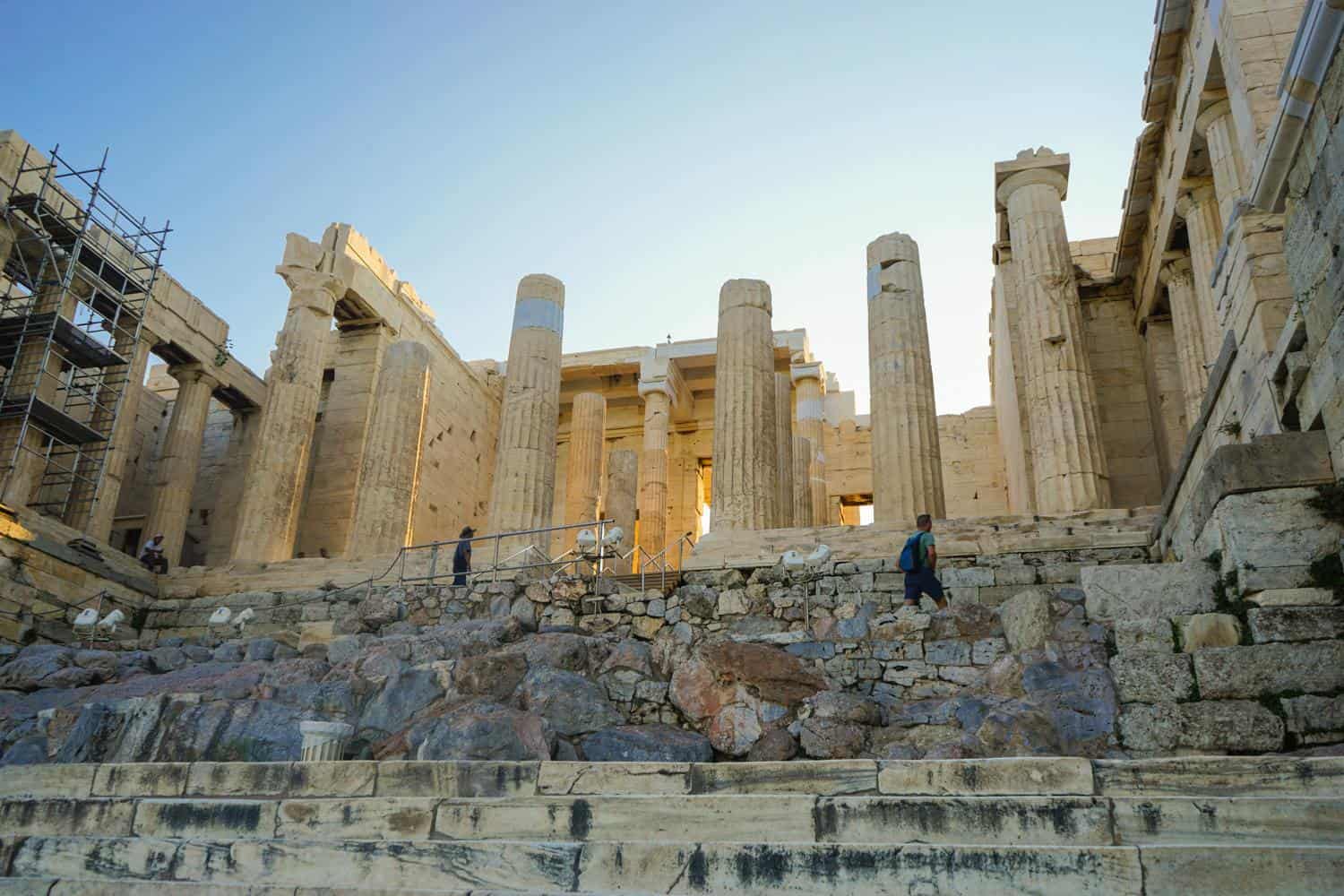
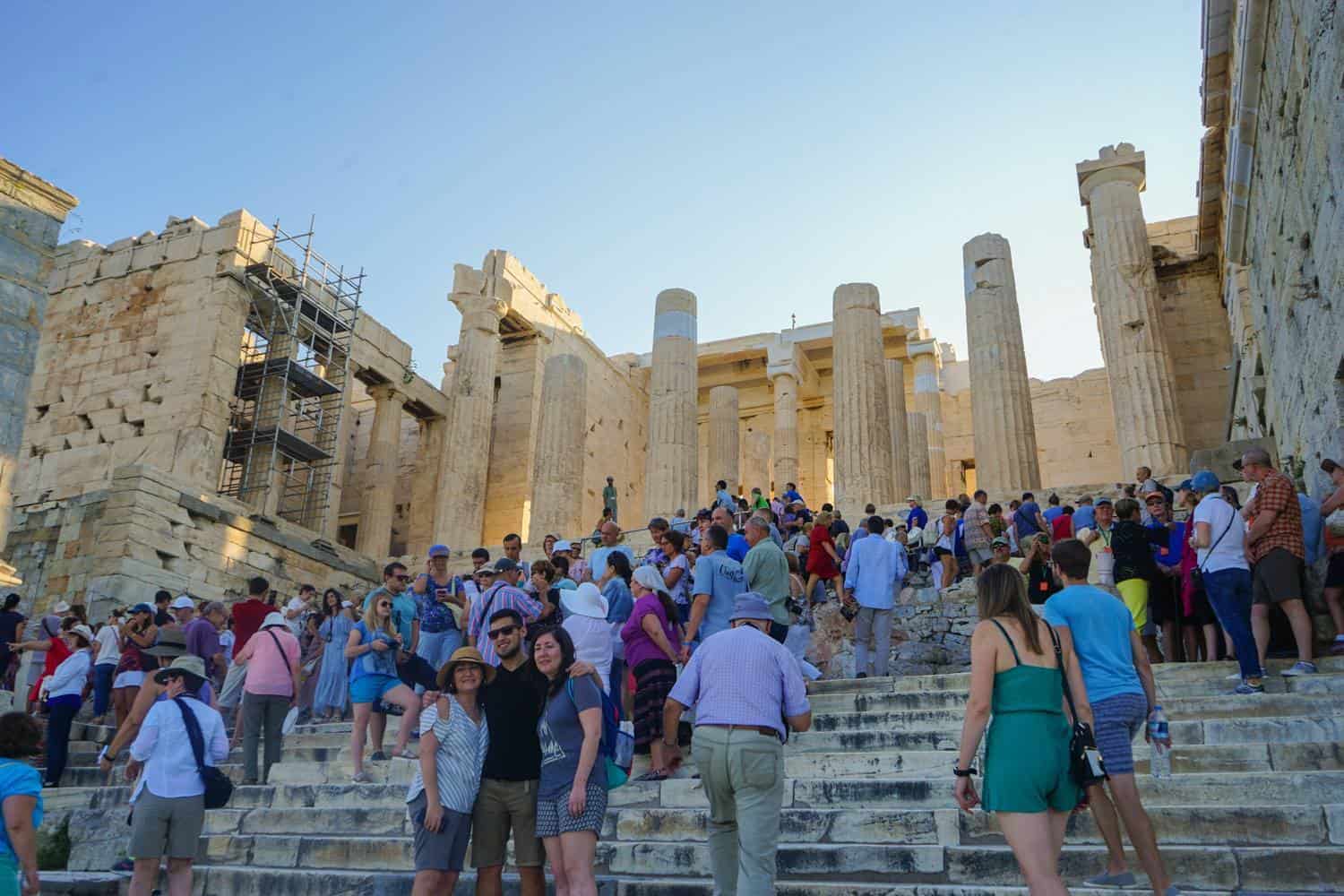
And why the southeastern gate, in particular? It has much smaller queues! It’s less popular with tourists, so you’ll be able to make your way to the Acropolis before everybody else.
My other top tip, for when you reach the Acropolis, is to race around and snap your photos, capturing the majesty of these structures without others around. But then, to take a moment to appreciate what you’re witnessing, rather than checking it out from behind your phone screen. Take a deep breath, take in the scene, and think about the history that has taken place in this spot.
Several minutes later, it’s time to start bracing yourself for crowds.
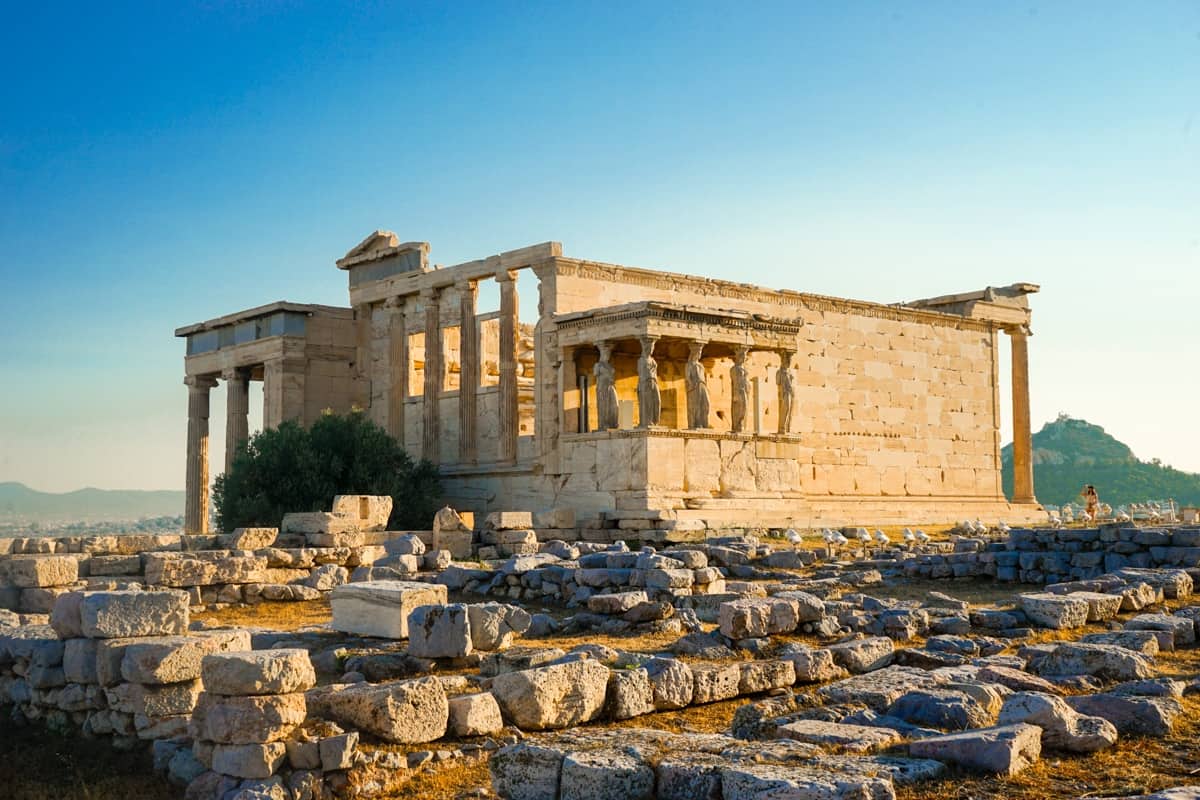
The Acropolis is the name given to the complex on top of the hill, and it’s made up of several individual buildings.
There’s the Temple of Athena Nike, the iconic Parthenon, the Old Temple of Athena, the Legendary Olive Tree of the Pandroseion, the Porch of the Caryatids at the Erechtheion… and on your way down, the Odeon of Herodes Atticus.
Oh, and while you’re exploring all of the monuments on top of the hill, make sure to wander off to the sides to snap some photos of Athens from above. I ended up taking some of my favourite photos from my time there.
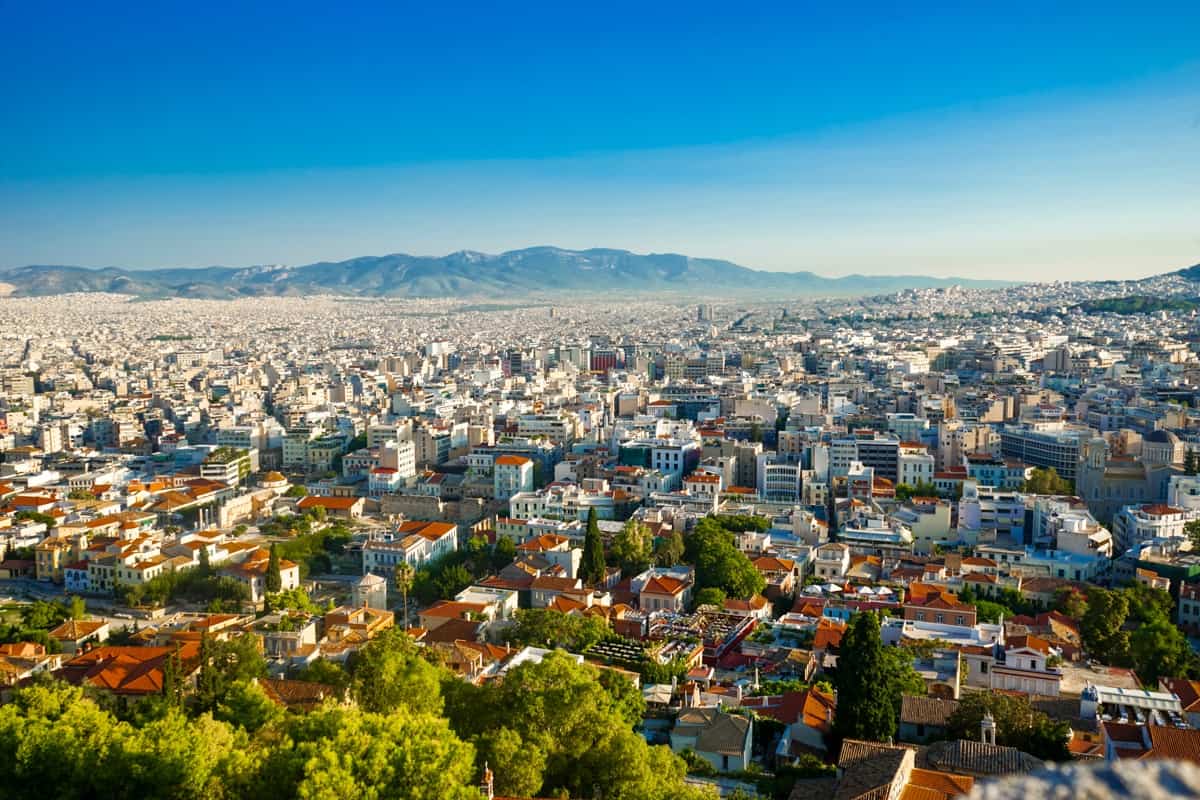
Something that sounds boring but isn’t is the Acropolis Museum, and I recommend spending a couple of hours there.
As someone who identifies as a museum-avoider, I listened to the recommendations of everyone who had been (they insisted I go inside!), and made myself check it out. And I loved it. The museum houses tons of sculptures unearthed from the Acropolis and it was fascinating to see them in person.
You’ll also get to learn about how my country took the Parthenon Marbles, plopped them in the British Museum, and refuses to give them back to Greece. Awkward.
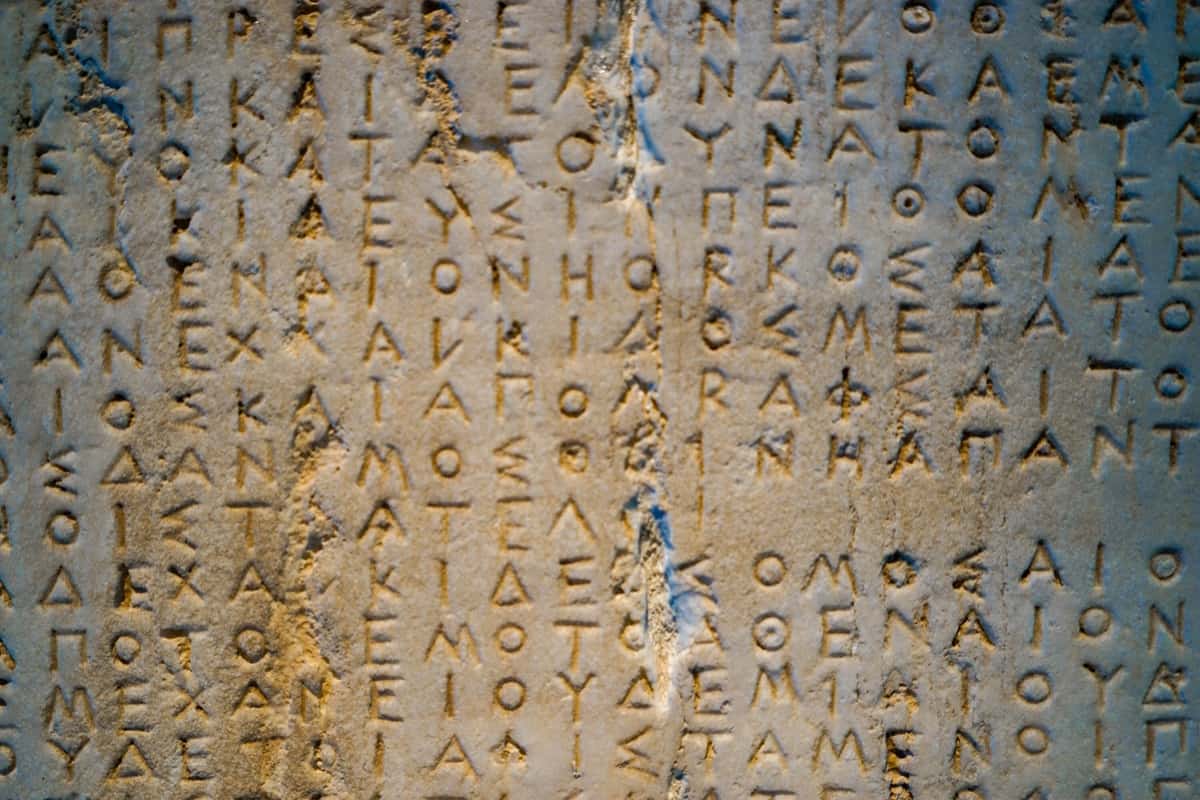
Head to Syntagma Square next to watch the changing of the guard. This takes place every hour on the hour, so attempt to time your visit perfectly. The guards wear fun outfits, march around in unison, and generally make for interesting photos.

From Syntagma Square, venture next to the enormous National Archaeological Museum to get your history on. This museum is seriously impressive and complements the ruin-themed explorations you’ve done so far.
When you emerge from the museum, you’ll be in the achingly cool Exarchia neighbourhood, which is one of my favourite parts of the city. It’s well-worth a wander and meal in the evening. So many great restaurants and bars! I especially recommend Atitamos for Cretan food and Giantes for excellent meals all round.
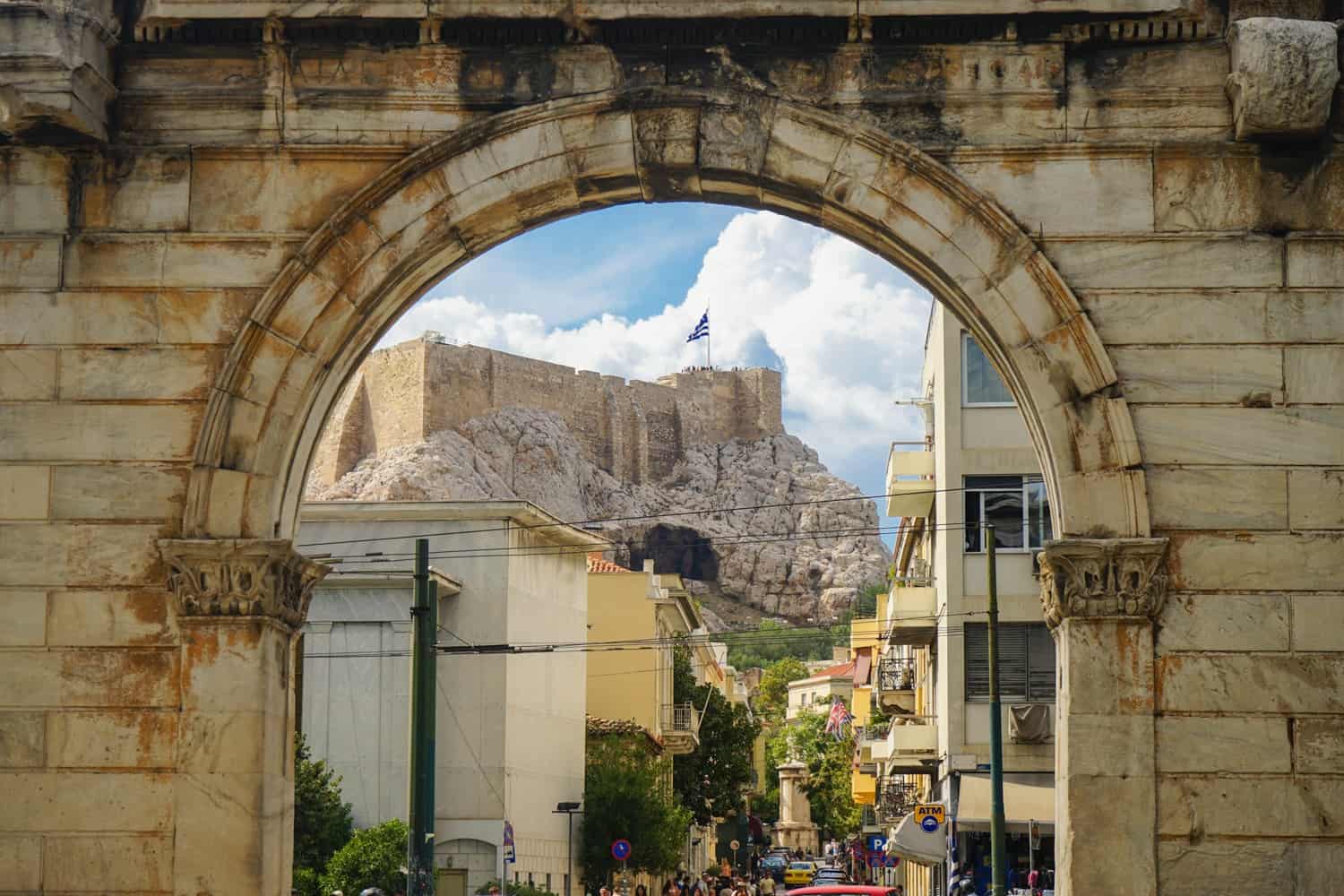
Day Three: Everything Else
We’ll keep this day more chilled out and spend most of the day crossing off the final remaining attractions on your combined pass. By this point, you’ve visited the Acropolis and checked out the Ancient and Roman Agoras, but you still have a handful of attractions to explore. Fortunately, these can all be seen fairly quickly.
Start your day by heading to Monastiraki for some ruins, architecture, and shopping. If you’re looking to stock up on tat souvenirs, this is the place to come. Opposite the Monastiraki metro station, you’ll find Hadrian’s Library and the Tzistarakis mosque — the former was built in 132 AD by Emperor Hadrian, and was the largest library of Athens. Today, it’s little more than a handful of columns, but you get free entry with your combo ticket, so it’s absolutely worth a wander around.
Beside the library is the mosque, which was built during Athens’ Ottoman rule.
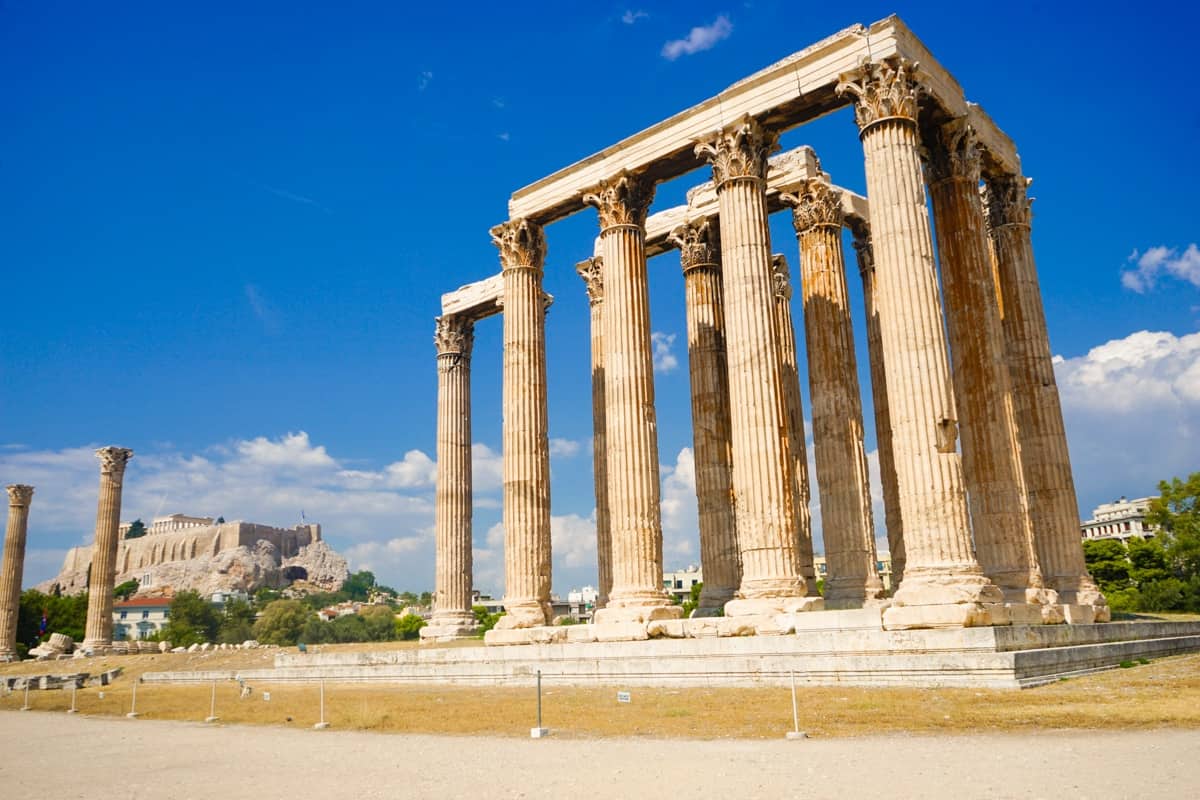
Next, head to Hadrian’s Gate for that picture-perfect photo of the Acropolis framed by the archway.
Just beside the gate is the Temple of Olympian Zeus, one of the largest temples in ancient Greece. To give you an idea of its size, in my photo above, you can see just 15 columns. When it was built, there were over a hundred.
From the temple, wander over to the Panathenaic Stadium to check out the world’s only stadium that’s built entirely of marble. Built in 330 BC, it was also home to the first modern Olympic Games, way back in 1896.
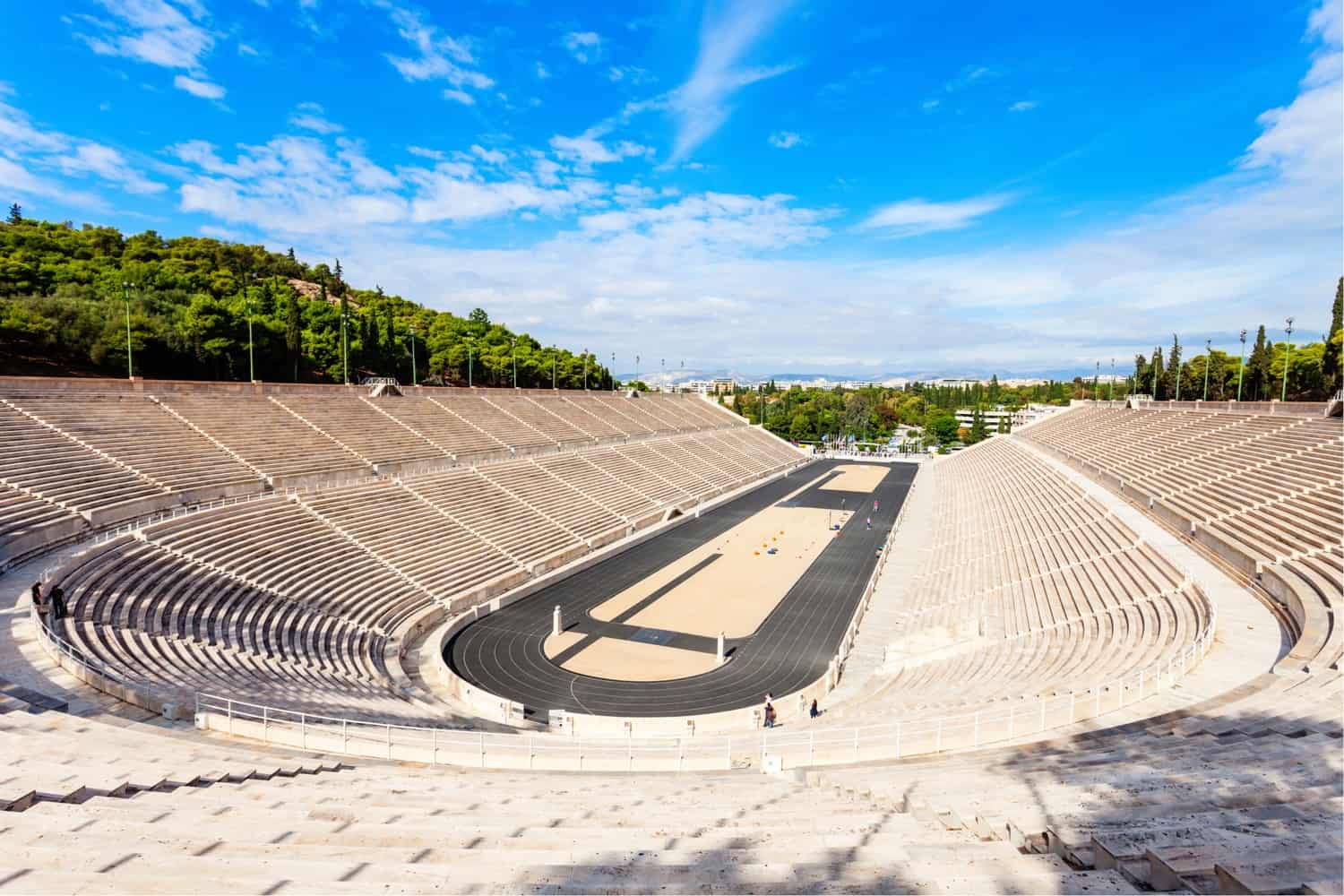
By this stage, you’re probably well and truly tired of staring at archaeological marvels, so grab a souvlaki from Monastiraki and head to the National Garden for a relaxing stroll and rest.
If you were wondering which of the sites from the combined ticket aren’t worth it, I’d have to go for Aristotle’s Lyceum. The ruins are far from impressive, relative to everything else you can see in Athens. The only reason to go is to see somewhere of great historical significance. This the school Aristotle founded in 335 B.C. and later taught at, along with Isocrates, Plato, and Socrates.
These days, it’s simply a bunch of rocks on the ground, so you likely won’t spend too much time staring at them.
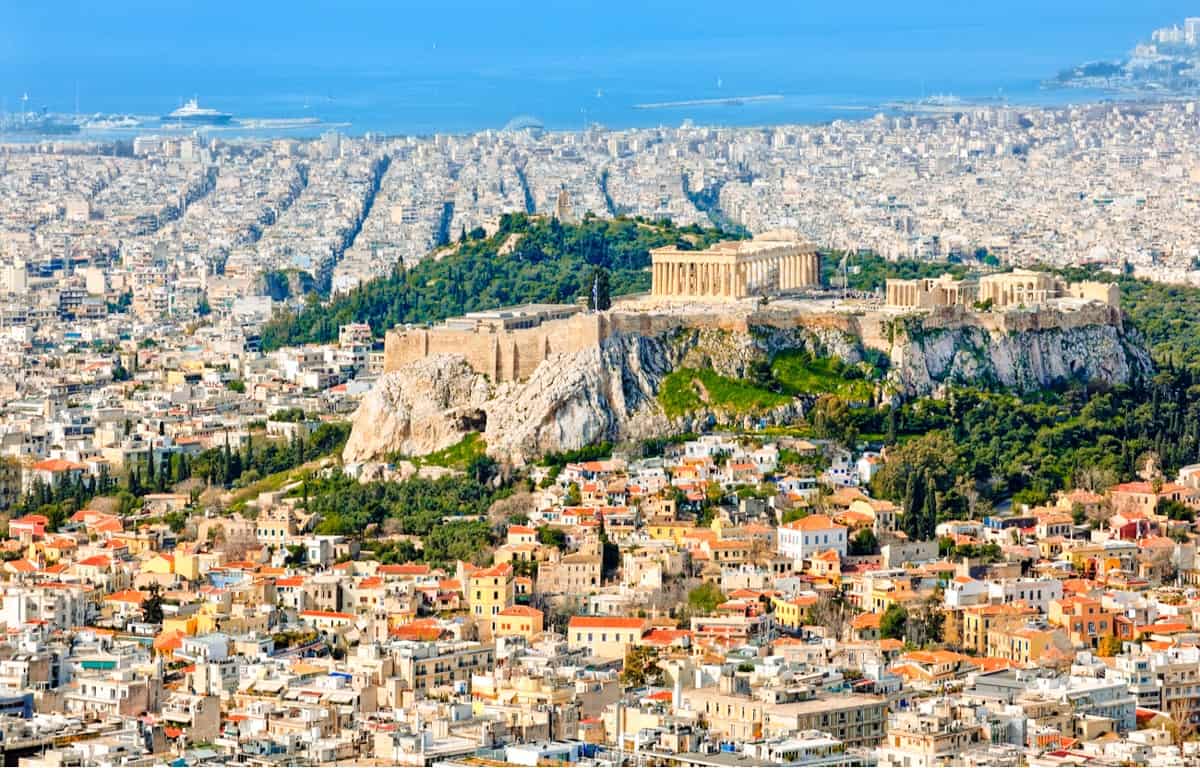
To round off your time in Athens, you’re going to want to head to Mount Lycabettus to get one of the best views over the entire city.
If you’re into walking, go for the hike to the top. It’ll take around 20 minutes, but the path is pretty steep. Otherwise, you can take a cable car or taxi to the top.
This is the perfect spot for sunset, looking down over the Acropolis and the sea.
The Best Time of Year to Visit Athens
August is the worst time of year to visit. Sorry, but it’s true! Like much of Europe, Athens is at its absolute worst in summer. It’s overwhelmingly hot (40°C/105°F!), crammed full of tourists and cruise ship passengers, and most of the locals have left in search of cooler climates. It’s not going to be disastrous if you do visit in August, but keep in mind that it’s going to get pretty uncomfortable as you explore those ruins in the heat.
The best time to visit Athens, then, is between March and May, and between September and November. During those breezy spring and autumn months, you’ll encounter balmy weather and plenty of blue skies, far fewer tourists (although you’ll want to avoid the weeks around Easter), and cheaper flights and accommodation.
What about visiting Athens in winter? Athens is quite a dry country, so you shouldn’t encounter too much rain, but it will be quite chilly. Between November and January, you can expect average temperatures of 10°C (50°F), and around 7-10 days of rain across each month. Snow is very rare. Still, the lack of crowds and very low prices are the prizes here, as well as one extra special bonus:
On every Sunday, between 1st November and 31st March, all of the main attractions in the city (including the Acropolis!) are totally free to enter. If you’re down for some low season travel, it’ll save you a bunch of money.
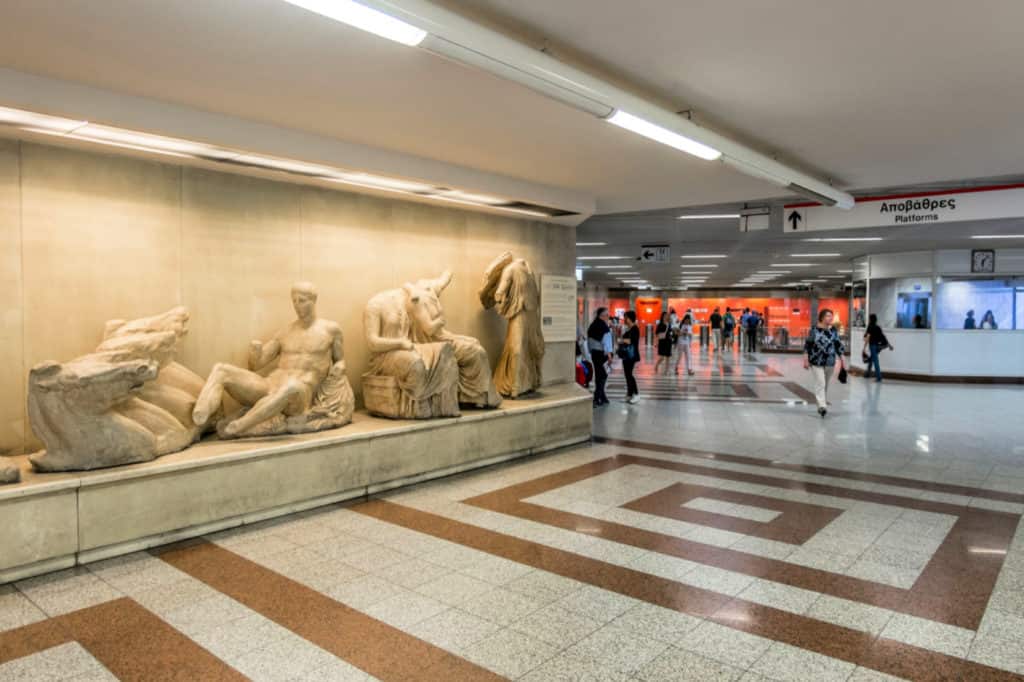
How to Get Around Athens
There’s Uber in Athens: That always makes getting around a less stressful experience! I used Uber to get from the airport to my hotel and from my hotel to the bus station when it came time to leave. No problems with either experience!
There is a Greek equivalent called BEAT, which is worth downloading before you arrive in the city. It has more drivers available than Uber, so if you plan on taxiing your way around town, will help save some time.
Consider the metro: I really enjoyed using the metro in Athens! It’s clean, easy to navigate, and cheaper than taking Ubers all over the city. A one-way ticket on the Athens public transport network costs €1.40 and allows you to use any method of transportation for 90 minutes. A day pass comes in at €4.50. The best value pass, however, is the €22 tourist pass. Valid for three days, it entitles you to unlimited travel around the city over that time, and includes a round trip to and from the airport. You can pick up your pass at the bus and metro ticketing area at the airport in the arrivals hall.
Traffic can be wild: The streets of Athens can be fairly chaotic for a European city, but it’s nothing too outrageous. Just enough, though, that I wouldn’t recommend renting a car while you’re in the city.
Where to Stay in Athens
You’ve got a lot to squeeze into your time in Athens, so you’re going to want to stay in a hotel that’s right in the heart of the action, close to Monastiraki Square. But most of all, you’re also going to want to stay somewhere quiet. Sleep is important, especially if you’re going to be fighting off jetlag.
I recommend staying in 360Degrees Pop Art Hotel, while you’re in Athens, as it ticks the boxes for both of those criteria, plus so much more. You’ll be staying just 200 yards from Monastiraki Square, in the heart of Athens, and next to a metro station, but because you’re not in the square, the rooms are quiet.
It’s a boutique hotel, which I much prefer over soulless chains, and the staff are only too happy to give travel advice and ensure you have the best trip ever. One of the best parts of staying in this hotel is the breakfasts! So good. And they’re eaten on a rooftop terrace, overlooking the Acropolis, which makes for a particularly epic start to your mornings.
Don’t Forget Travel Insurance!
And finally, I’m a firm believer that if you can’t afford travel insurance, you can’t afford to travel, and this holds true for every country in the world.
Travel insurance will offer compensation if your flight gets cancelled, pay for you to replace your lost luggage, cover your medical bills if you get struck down with appendicitis, and ensure you don’t face any emergency travel costs to get back home for a family emergency. Nobody likes to think about things going wrong on their trips, but travel insurance is a must to ensure you’re not out thousands of dollars if the worst case scenario comes true.
I use and recommend SafetyWing travel insurance for visitors to Athens. They provide worldwide coverage, don’t require you to have a return ticket, and even allow you to buy coverage after you’ve left home. Finally, they have a clear, easy-to-understand pricing structure, which is always appreciated.
Related Articles on Greece
🇬🇷 11 Highlights From My First Trip to Greece
🧳 A Carry-On Packing List for Sailing in the Greek Islands
⛵️ Conquering My Fear of Sailing in Greece







Loved this guide! I loved Athens when there back in 2010 – but traveled in Greece with a terrible ex. The whole time knew I’d love to come back and experience it anew with the right person. Me, my husband & baby are finally making it over to mainland Europe this fall (Barcelona & Berlin), and this makes me want to put Greece at the top of the list for our next European trip.
Thank you for all you do! I’ve always loved reading your writing, and so happy to see new blogs up. Haven’t commented before, but really, really appreciate your candor, humor & info!
While I love your writing, having been to Athens before, I just wanted to say how much I loved your photos in this post! And in the photo of you, you look good and healthy! So I hope you’re also feeling that way!
Ah, thank you so much, Scott! That means a lot :-) I’m definitely feeling a whole lot better!
After having been to greece and athens many times , I can say that your photos and your views on athens are very good. Our daughter has lived in greece for nearly 20 years, and every time we go , I fall in love with it a little more. She used to live in Pangrati, which is a 20 min walk from Plaka and approx 15 mins from the marble stadium. Since then she and her husband and children have moved closer to the coast, which although it is about 45 mins away from the city, is beautiful ,and clean, and a pleasure to visit. One more thing to pass comment on is the warmth and Friendlinessof the Greek people. Especially if you take the time to learn a few greek words. They think it’s wonderful.
Wonderful post, Lauren, and I love the tips on how to beat the crowds.. I’ve never been to Athens but I’ve got a feeling that Greece is just my kind of place – you get that vibe from some places sometimes that you’re drawn to.
Fabulous photos & tips, Lauren, thank you. Wish I could do European city breaks like that but it’s too far from Toronto :)
Best wishes on your travels, Georgia
Great tip to visit the Acropolis after the other sites. Are the crowds the largest in the morning or the afternoon? I was wondering what it would be like later in the day before it closes. Athens is definitely on my radar :)
I think it’s fair to say that Athens is the most underrated capital city in Europe.
Thanks for this great post! I love that you included Anafiotika and the often-overlooked Kerameikos – I don’t think enough people get to see this fascinating site and the great little museum in it. Your before-and-after photos of the Acropolis entry were trippy! Talk about a picture being worth a thousand words! :^D
I liked the Acropolis very much, and I agree it’s best to combine sightseeing with the Acropolis Museum. This way you can get to know this place better.
Hi, great blog! .Just a couple of tips to add. Entrance fees are all reduced by half in the Winter and unless you plan to go to all the sites and museums it covers its actually cheaper to pay individually. And whatever time of year you go, book your Acropolis tickets in advance, the queues at the ticket desk are horrendous, even at Christmas when we went!
Thank you for adding those, Caroline! :-)
Athens is a beautiful city with a lot of ancient landmarks.
The city centre is pretty compact and most landmarks are easily to reach by walking.
Perhaps, our navigation system for the metro (subway) of Athens could be useful as well.
https://www.metrocazar.com/athens/
I love Athens! I just spent nine days there and was blown away by it. It felt unlike any European city I’ve visited. I also feel so fortunate to have gone right now just as tourism is restarting in Greece, because I totally took it for granted when I rolled up to the Acropolis at 11 am and there were still no crowds whatsoever. I had forgotten what it’s probably like normally until I saw that photo you snapped of the crowds!
Ah, amazing! Yeah, it’s been much the same in New Zealand during the pandemic — the lack of crowds at major tourist attractions has been incredible to experience! The crowds at the Acropolis were truly intense when I visited, and that was during September, so not even the peak of high season.
Hello, l came across your post on Athens and is has been so helpful planning my trip. We leave in a few days. One question, the view from he rooftop bar is amazing, can you tell me the name of it?
Thank you so much
A for Athens was the name of it! There’s quite a few bars and cafes in Monastiraki Square that will give you a similar view, too :-)